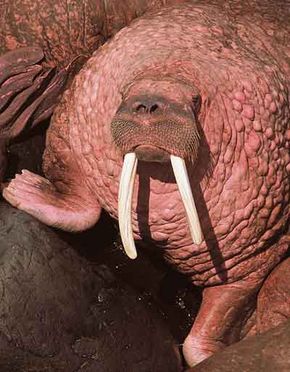Walrus Environmental Adaptations
Walruses live in one of the harshest environments on Earth. Not only do they dwell where temperatures are frigid -- they also spend the majority of their time in the water, where they lose body heat 27 times faster than they do on land. Yet the walrus manages to maintain a core body temperature of 97.9 degrees Fahrenheit (36.6 degrees Celsius). Walrus skin generally stays one to three degrees warmer than the water, and the animal's metabolism is not affected at temperatures between -4 degrees and 59 degrees Fahrenheit (-20 degrees Celsius to 15 degrees Celsius). Some walruses have even been observed unaffected by water temperatures as low as -31 degrees Fahrenheit (-35 degrees Celsius) [source: Burns].
So, how do they do it? With good insulation; walruses have a thick layer of body fat just under their skin that keeps them warm, streamlines their form and provides them with energy when reserves dip low. This blubber layer can be up to 3.9 inches (10 cm) thick and may comprise up to a third of the animal's body mass in the winter [source: Burns]. The walrus's blood vessels also constrict and move blood away from skin and toward chief organs, where heat won't escape. When the temperature is cold or a walrus has been underwater for a long time, its skin appears white for just this reason. When a walrus is warm, its skin takes on a pinkish hue as the blood vessels dilate and blood returns to the skin's surface to let heat escape. Walruses do have hair, which they gradually shed and replace over the summer months. But this hair is only 0.3 to 0.5 inches (7mm-12mm) long and plays little, if any, role in keeping the animals warm.
Advertisement

On top of being good at tolerating the cold, walruses have acquired several adaptations that enable them to go long periods without oxygen. This ability is connected with their circulation. When they dive, their heart rate slows and blood travels to the organs that need the most oxygen. In addition, walruses have a high level of a protein called myoglobin in their blood. Myoglobin binds to oxygen, carries it through the walrus's body and stores it in the muscles. Also, pharyngeal muscles in the walrus's throat close up when they dive to prevent water from entering the animal's lungs.
To learn more about walrus behavior and to find out how a male walrus wins over its mates with a sonorous serenade, go to the next page.
